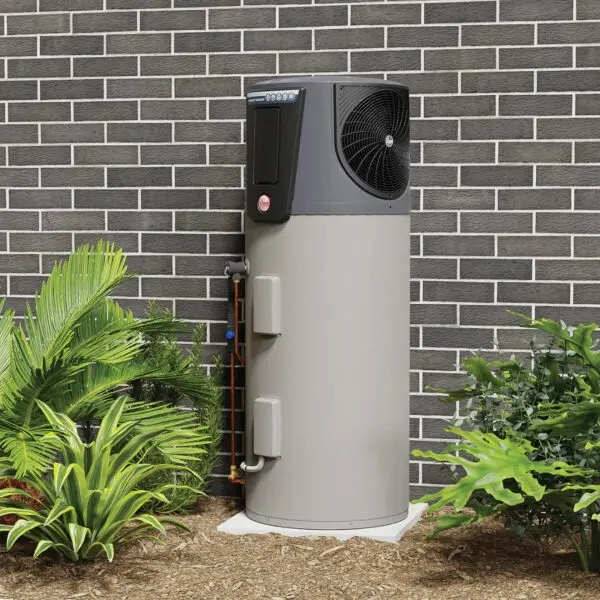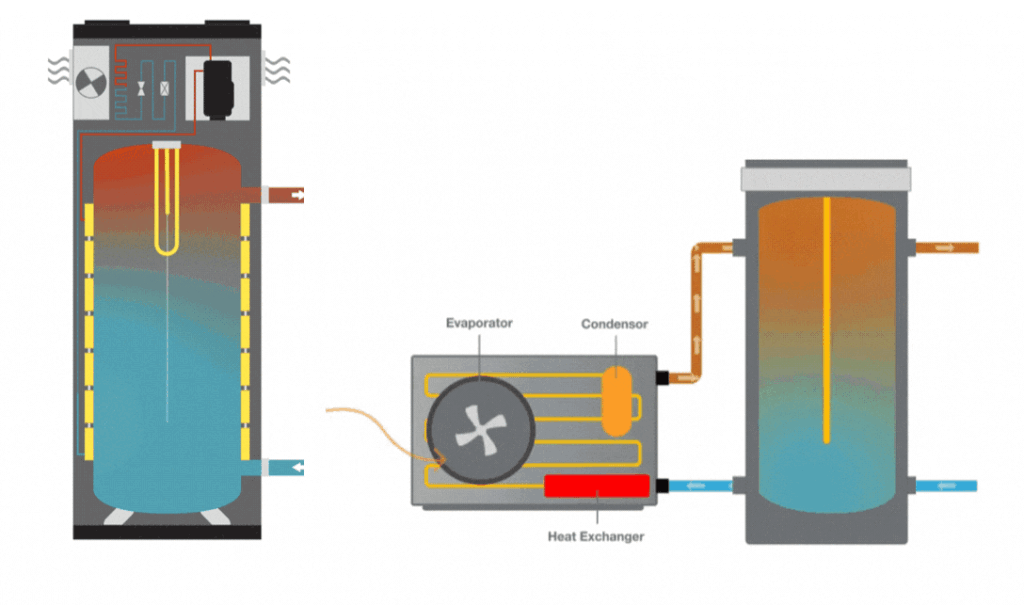Everything You Need to Know About Heat Pump Hot Water Systems – FAQ

A heat pump is a clever device that moves heat from one place to another, which makes it useful for heating, cooling, and even refrigeration. The best everyday example is your fridge. At the back, down near the bottom, there’s a small compressor that pushes a special fluid called refrigerant around. As it cycles, the fridge pulls heat out from inside and dumps it out the back. That heat then drifts upward, while the inside of the fridge gets chilled over time.
What is a Heat Pump Hot Water Service (HWS)?
A heat pump hot water system works a bit like a fridge in reverse. Instead of pulling heat out of the fridge and releasing it outside, it takes heat from the surrounding air and transfers it into a water cylinder. This process can heat the water up to around 60 °C, while the air around the unit becomes cooler.
Heat pump hot water systems (HWS) come in two main types: split and integrated.
Both options work well, though at YESS we often see integrated systems more commonly.

Integrated systems combine everything in one unit, with the storage cylinder at the bottom and the working parts on top.
Split systems keep the storage cylinder separate from the evaporator, fan, and compressor, connected by refrigerant piping. They’re usually quieter and more efficient, but come at a higher price.
Do heat pumps save you money?
Yes! Heat pumps use 60–75% less energy than conventional hot water systems. With rising natural gas prices and increasing regulations, they’re also a smart, future-ready alternative.
Are heat pumps noisy?
Not really. Good models run at 40–50 dB—a low hum, similar to a fridge or air conditioner. Advanced insulation and vibration-reduction technology keep noise minimal. If you’re concerned, unit placement can be optimised during installation. Make a note on the YESS’ expression of interest form to explore options.
Does it matter where I live?
Not really! Heat pumps can work almost anywhere, even in cold climates. They draw on the heat that’s always present—much like a fridge pulls heat from its interior. While heat pump hot water systems are most efficient in warmer conditions, households in the Adelaide Hills or southern parts of the state can still enjoy strong performance and worthwhile savings throughout winter compared to traditional electric or gas systems.
(And when we say “heat,” we mean energy—so even when it feels cold to us, there’s still usable heat for the pump.)
Do heat pumps use electricity?
Yes—but much less than traditional hot water systems! Heat pumps are smart and energy-efficient, and you can save even more if you plan carefully.
Timers or smart apps – Even without solar, you can schedule your heat pump to run during off-peak or cheaper electricity times, keeping costs down.
Holiday mode – Many systems let you reduce heating to a minimum while you’re away, so energy isn’t wasted.
Solar or battery power – If you have solar panels (or solar plus a battery), your heat pump can run on clean, renewable energy. That’s a big win for low-cost, green living.
Where are they made?
Most heat pumps are made in China, but origin doesn’t always determine quality. Some Chinese-made models are world class. Some units are assembled or repackaged in Australia using imported components. If you have a preference, just ask before purchasing
What is the reheat rate?
The reheat rate (or recovery rate) is how fast a heat pump can heat water back up for use, measured in litres per hour. It’s important if your household uses a lot of hot water. If you’re more conservative, it may not matter much—but if you love long hot showers, choose a system with a strong reheat rate so you’re never left cold.
Some heat pumps also have backup boosters to help when the outside air is cooler.
Other factors that affect how quickly your water heats:
Ambient conditions – air temperature, humidity, and how well the area around the unit is ventilated.
System design – split systems with Japanese-made compressors perform best, though they come at a premium.
Incoming water temperature – colder in winter, warmer in summer.
What warranty comes with a heat pump HWS?
Warranties usually cover a few key parts:
- Tank/cylinder: 5–15 years
- Heat pump/compressor: 2–8 years
- Labour: 2–5 years
- Other parts (like the electronic controller): 2–5 years
Remember, a warranty is only as good as the company behind it. Always check both the coverage and that you’re comfortable with the supplier—after all, a long warranty doesn’t help if the company can’t honour it.
What size heat pump should I get?
Picking the right size ensures hot water when you need it, without paying for more than you use.
- Bigger isn’t always better – If your household uses water steadily throughout the day, a smaller tank with a strong recovery rate can be more effective than a huge tank.
- Peak usage matters – If everyone showers around the same time, a larger tank makes sure there’s plenty of hot water quickly.
Tank sizes (typical):
- 150–200 L → 1–3 people
- 300–400 L → 6+ people
Can’t decide? Jot it down in the expression of interest form and get guidance to help you decide.
